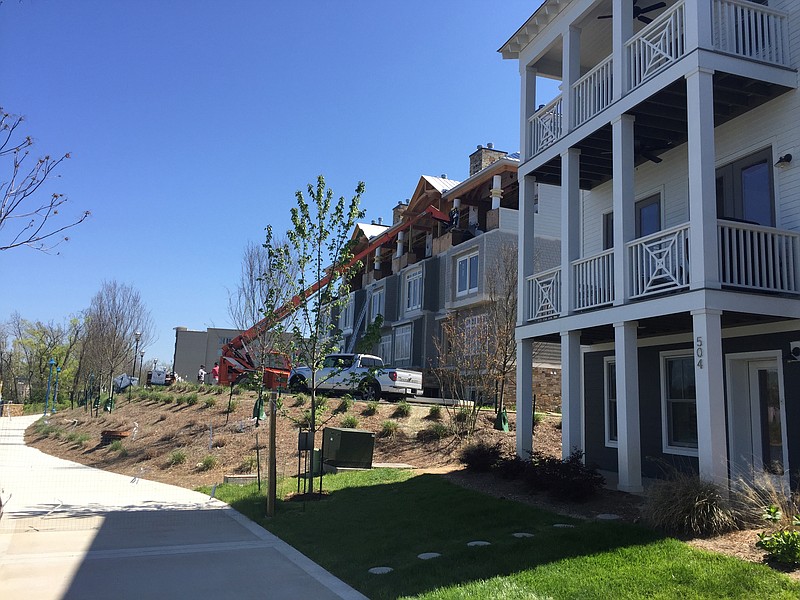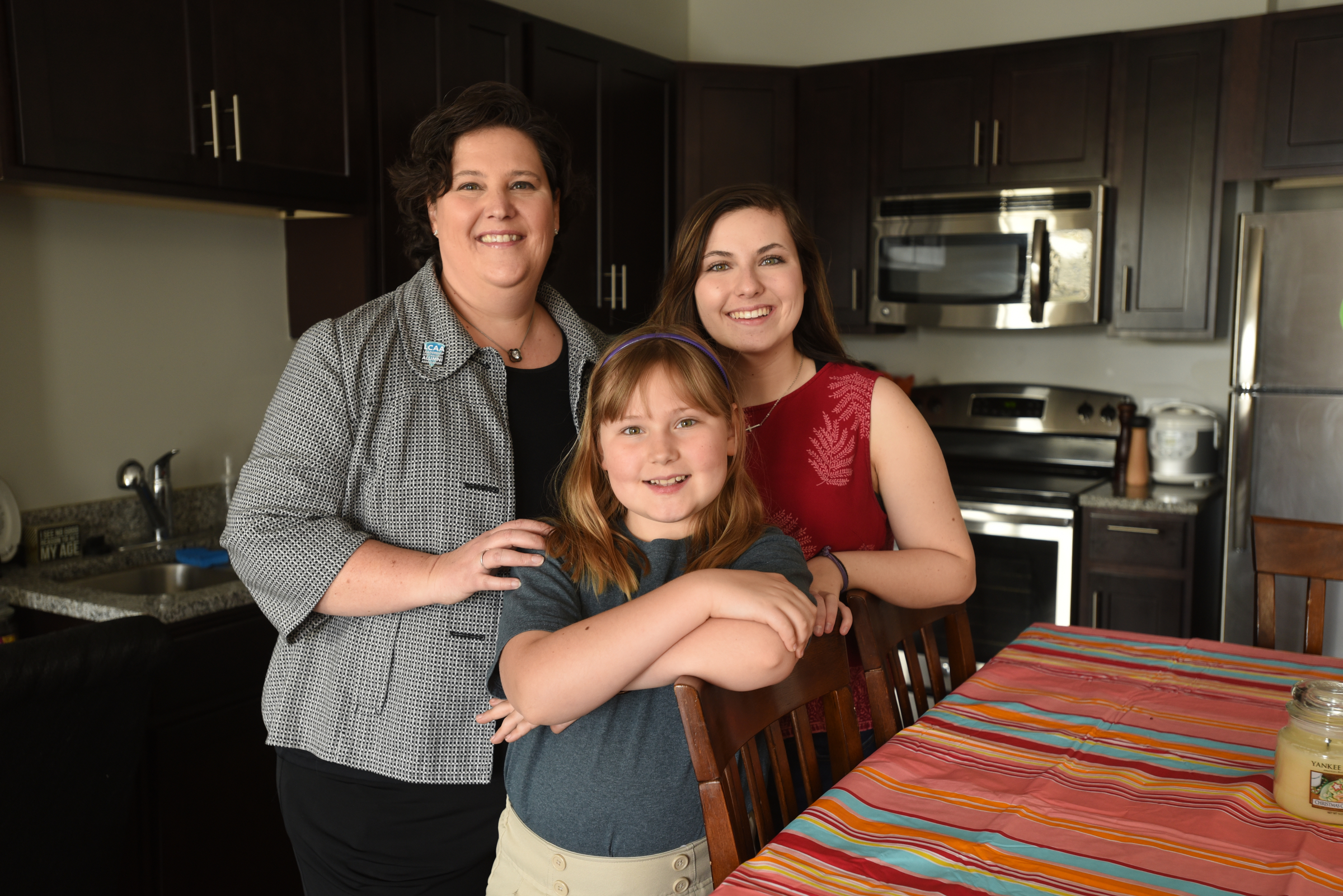Last year, Penny Hughey and her daughters sold their flat-screen TVs. Nine-year-old Anna Kate sold off her stuffed animals, and her older sister Kinsey thinned out her wardrobe. Penny sifted through family keepsakes, getting rid of inherited dishes, cookware, books and boxes of memorabilia.
Yes, it was hard, they say. But what the family gave up to downsize from their three-story home in Ringgold to the Tennessee riverfront has been worth it, the three agree. The family recently moved into an apartment in Cameron Harbor, a $100 million waterfront development.
Tucked away behind the corporate offices of BlueCross BlueShield and just next to Alstom Power along the Tennessee River, Cameron Harbor has been years in the making.
Developer Eugene "Buck" Schimpf purchased the 23-acre property in 2008, and, since then, has been quietly planning a future for one of the last remaining pieces of untouched downtown riverfront. He waited out the housing market crash, knowing his patience would bring success to the small slice of the city where he saw such potential.
In 2014, in collaboration with Nashville-based Evergreen Real Estate, Schimpf began to build his dream. A year later, the first of his tenants and homeowners began to move in. Phase 1 of Schimpf's $100 million dream brought one apartment building, 10 riverfront homes and 17 village homes to the Harbor. Construction for Phase 2, with a second apartment building and 27 Craftsman homes, is ongoing.
"People thought I was crazy to move downtown with the girls," says Hughey. But, she says, she and the girls realized they were spending the majority of their time along Market and Broad Streets, on the North Shore and beyond anyway.
Of the roughly 220 available apartment units, one of which Hughey and her girls now call home, all are either occupied or pre-rented. The majority of the 73 planned Craftsman cottage homes have sold, as well.
"To me it is just a natural extension of downtown Chattanooga," says Schimpf. "It's using an asset that heretofore has been underutilized."
To understand the history of development along the riverfront, one has to go back to the inception of River City Company, the nonprofit champion of downtown Chattanooga development, which saw the draw of the river long before developers ever did.
"River City knew that more downtown housing was needed," says Marketing Manager Amy Donahue. "But it was uncharted territory for private housing developers. So we embarked on Riverset Apartments, which was the first downtown housing project in over 20 years."
Situated along Riverfront Parkway next to the then-new Tennessee Aquarium, Riverset, which opened in 1993, paved the way for future developments such as Cameron Harbor. River City's goal has never been financing development, Donahue notes, merely facilitating it. But in this instance, the company took a gamble - and it paid off. In just a few months, Riverset was sold out. And, after Riverset, development took off rapidly along the river.
But until now, what the riverfront has lacked are single-family homes for those willing to intertwine their futures with downtown's developing waterway. Cameron Harbor offers two apartment buildings with a variety of one- and two-bedroom rentals with prices between $1,400 and $1,700 a month, Craftsman homes ranging in price from $335,000 to $500,000 and luxury townhomes selling for a whopping $1.2 million. Schimpf's goal with Cameron Harbor is to create a diverse community along the waterway, one that is attractive to small businesses and mixed-use development.
"You've got the North Shore and the Southside and downtown, but I think this is the hottest commodity," Darlene Brown says of Cameron Harbor, for which she is the managing real estate broker. " It's truly something unique and I think you'll see this become a destination."
But what is it that sets Cameron Harbor apart? What about it inspires families like Hughey's to downsize 75 percent and change schools to be there? Or others to invest $1 million or more for a piece of Schimpf's vision?
For starters, there's the Riverwalk, located next door to Cameron Harbor, which connects downtown with recreation, multi-modal transportation and nature as it takes users along the waterfront, all the way to East Ridge. Coupled with the draw of the water, the paved public access trail makes for a powerful perk, Schimpf says.
"We traded a nearly 4,000-square-foot house with a pool and a yard for this," says Hughey, gesturing off her balcony at the view of the river and the accessible Riverwalk below. Although she says that seems inconceivable to many, Hughey stands by the decision - as do her two girls, even though they're now sharing a room in an apartment that's nearly 3,000 square feet smaller than their former family home. "But we would absolutely all do it again the same way," Hughey says. " We gave up a backyard, but we gained all of Chattanooga as our backyard."
That sort of testimonial is what Trust for Public Land Director Rick Wood loves to hear. It's the mentality that has driven his work and career for years, inspiring him to raise funding for and manage projects such as the Riverwalk. "That's the story. That's the goal," Wood says, "for people to choose to live next to that kind of investment, that amenity for everyone. And it's just amazing to hear that is happening.
"The Riverwalk is a model for so many in the city," he adds. "When Chattanooga re-embraced the river, the amenities along it started coming. But they aren't all big pieces. Some of them are very small. But it is an investment with a major economic return and has helped reform this city. It makes living downtown, working downtown and being downtown just great."
A key difference between the early 1990s, when Riverset was built, and now is that people already understand the appeal of living in urban areas. "And in Chattanooga, we're very lucky that the urban area is surrounded by the Tennessee River," Donahue says.
Matt and Laura Patterson agree. With both working downtown jobs, at Bellhops and BlueCross BlueShield, respectively, purchasing nearby was the biggest priority. When they found their three-bedroom, four-bath dream home in the form of one of Cameron Harbor's first Craftsman houses, they knew it had everything they wanted - and more.
Formerly residents of the Art District area, the Pattersons say the appeal of having a hand in designing their own home's layout as well as the opportunity to live along the river were too good to pass up.
After moving in last fall, long walks along the riverfront with their basset hound have become a refreshingly simple after-work activity. Stepping outside their door, they have access to a whole network of neighbors and opportunities to connect to the city they've committed to. "Since moving in, we've really gotten to know our neighbors," Matt Patterson says. "It's started to really become a community as more and more people have moved in. And we just love it here."
As the Riverwalk continues to expand, the Cameron Harbor area will only continue to develop with it. Though Schimpf and Brown say they don't want to speculate on exactly what the Harbor area will become, change is imminent, they agree.
For Hughey's tight-knit family, settling into their new apartment means morning walks to the bus with her daughters, and for 16-year-old Kinsey, it means more freedom and opportunities for autonomy than many her age have access to without a car. "If my friends want to do something, I can go grab a Bike Share bike and meet them," she says.
There are a growing number of days when the family car sits unused in the parking lot, adds her mother. The surrounding area has come a long way in the 23 years since Riverset brought some of the first riverfront residents to the balconied apartments just off the Market Street Bridge. Restaurants overlook the shoreline. One of the largest indoor rock climbing facilities in the country opened just a few blocks away. You can go shopping or to a movie.
The concentration of hotels speaks to the amenities and appeal.
"Once you add residential, it becomes very lucrative for commercial and service industries to follow," says Donahue. "Think about where you live. You probably frequent restaurants, services, grocery stores and more that are located near your home. One of the big issues that we have faced as a city is recruiting and supporting existing retail and restaurants, because we haven't had the residential population that's truly necessary. With development like Cameron Harbor and more on the way, you will see many more retail, restaurant and service options."
However, Brown cautions, don't assume a future for Cameron Harbor that hasn't happened yet.
"I think as soon as you start trying to define that, you can be made a liar," she says. "We want a diverse group of people. We don't want to try to control it we want to have something for everyone. It will take on its own personality.
"I don't think people set out to make the Southside as cool as it is, it just became that way. And Cameron Harbor will take on its own personality as well."

